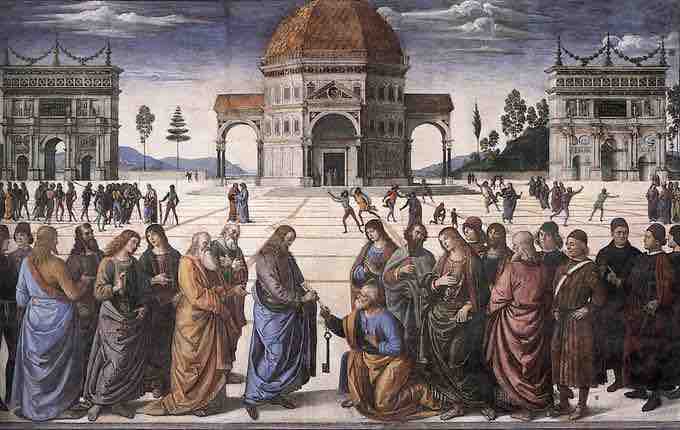In art, perspective is an approximate representation on a flat surface of an image as it is seen by the eye, calculated by assuming a particular vanishing point. Systematic attempts to evolve a system of perspective are usually considered to have begun around the 5th century BCE in the art of Ancient Greece. By the later periods of antiquity, artists—especially those in less popular traditions—were well aware that distant objects could be shown smaller than those close at hand for increased illusionism. But whether this convention was actually used in a work depended on many factors. Some of the paintings found in the ruins of Pompeii show a remarkable realism and perspective for their time.
The earliest art paintings and drawings typically sized objects and characters hierarchically according to their spiritual or thematic importance, not their distance from the viewer. The most important figures are often shown as the highest in a composition, also from hieratic motives, leading to the "vertical perspective" common in the art of Ancient Egypt, where a group of "nearer" figures are shown below the larger figure(s).
The art of the Migration Period had no tradition of attempting compositions of large numbers of figures, and Early Medieval art was slow and inconsistent in relearning the convention from classical models, though the process can be seen underway in Carolingian art. European Medieval artists were aware of the general principle of varying the relative size of elements according to distance, and use and sophistication of attempts to convey distance increased steadily during the period, but without a basis in a systematic theory.
By the Renaissance, however, nearly every artist in Italy used geometrical perspective in their paintings. Not only was this use of perspective a way to portray depth, but it was also a new method of composing a painting. Paintings began to show a single, unified scene, rather than a combination of several. For a while, perspective remained the domain of Florence. Gradually, and partly through the movement of academies of the arts, the Italian techniques became part of the training of artists across Europe and, later, other parts of the world.

Perspective in Renaissance Painting
Pietro Perugino's usage of perspective in this fresco at the Sistine Chapel (1481–82) helped bring the Renaissance to Rome.
A drawing has one-point perspective when it contains only one vanishing point on the horizon line. This type of perspective is typically used for images of roads, railway tracks, hallways, or buildings viewed so that the front is directly facing the viewer. Any objects that are made up of lines either directly parallel with the viewer's line of sight or directly perpendicular (the railroad slats) can be represented with one-point perspective. These parallel lines converge at the vanishing point.
Two-point perspective can be used to draw the same objects as one-point perspective, but rotated—such as looking at the corner of a house, or looking at two forked roads shrink into the distance. In looking at a house from the corner, for example, one wall would recede towards one vanishing point and the other wall would recede towards the opposite vanishing point.
Three-point perspective is used for buildings depicted from above or below. In addition to the two vanishing points from before, one for each wall, there is now a third one for how those walls recede into the ground. This third vanishing point would be below the ground.
Four-point perspective is the curvilinear variant of two-point perspective. The resulting elongated frame can be used both horizontally and vertically. Like all other foreshortened variants of perspective, four-point perspective starts off with a horizon line, followed by four equally spaced vanishing points to delineate four vertical lines. Because vanishing points exist only when parallel lines are present in the scene, a perspective with no vanishing points ("zero-point") occurs if the viewer is observing a non-rectilinear scene. The most common example of a nonlinear scene is a natural scene (e.g., a mountain range), which frequently does not contain any parallel lines. A perspective without vanishing points can still create a sense of depth.